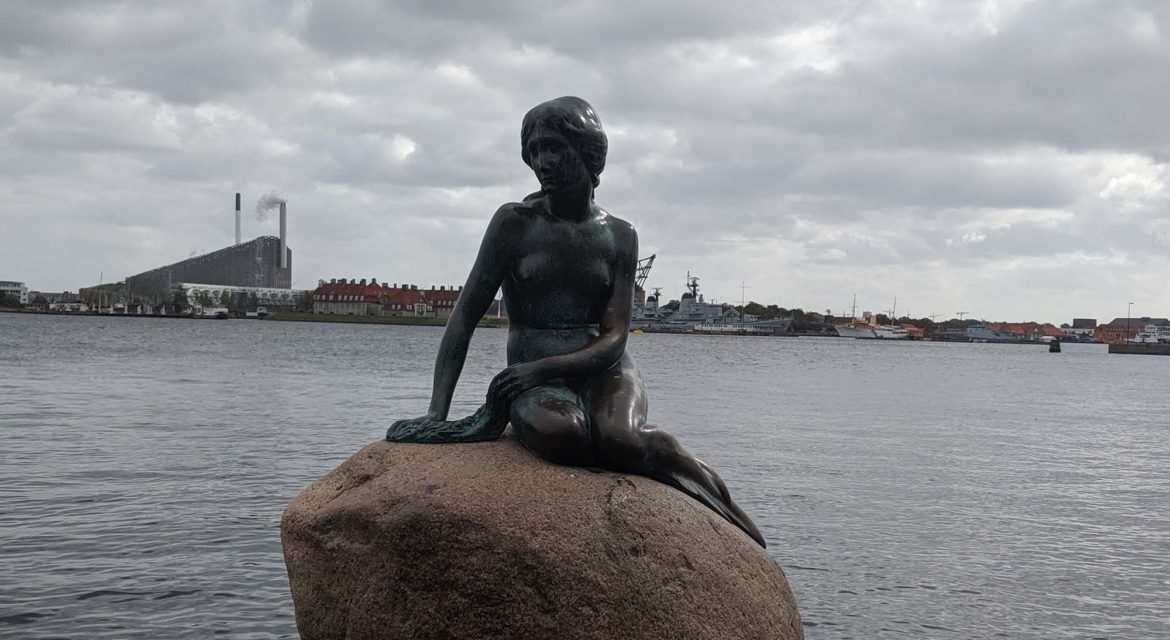 Inspired by Hans Christian Andersen’s fairy tale about a mermaid who gives up everything to be united with a young, handsome prince on land, the Little Mermaid statue in Copenhagen, Denmark is as unassuming as it is influential. Slightly bigger than life-size, the statue has been a major tourist attraction ever since it was first installed and continues to draw crowds by the busload.
Inspired by Hans Christian Andersen’s fairy tale about a mermaid who gives up everything to be united with a young, handsome prince on land, the Little Mermaid statue in Copenhagen, Denmark is as unassuming as it is influential. Slightly bigger than life-size, the statue has been a major tourist attraction ever since it was first installed and continues to draw crowds by the busload.
Like other iconic statues and sculptures, it has come to be recognized as the symbol of Copenhagen and even Denmark as a whole. Doing so has enabled an incredible economic and cultural impact on the city and region.

From Fairytale to the Ballet to the Waterside
“The Little Mermaid” is a fairy tale by Hans Christian Andersen about a young mermaid who is willing to give up her life in the sea and her identity as a mermaid. The Danish author published the story in 1837, but it has been adapted to various media since then, and that includes a ballet in Copenhagen’s Royal Theatre in the early 1900s. Carl Jacobsen of Carlsberg Breweries saw the play and was inspired to provide support for a piece that would celebrate the story.
 Commissioned in 1909, the statue was created by Edvard Eriksen and was unveiled in August of 1913. The ballerina in the play was asked to model for the statue but refused to model in the nude. The face of the statue was modeled after her, but Edvard Eriksen’s wife posed for the body of the piece.
Commissioned in 1909, the statue was created by Edvard Eriksen and was unveiled in August of 1913. The ballerina in the play was asked to model for the statue but refused to model in the nude. The face of the statue was modeled after her, but Edvard Eriksen’s wife posed for the body of the piece.
The statue was popular immediately, drawing attention and crowds from across the city and Denmark. However, that attention has come in all forms ever since it was erected since the statue has on multiple occasions lost its head and been covered in paint. Most of these acts of vandalism are designed to make a statement about something bigger, such as the covering of the statue in red paint being a statement about the hunting of pilot whales around the North Atlantic islands that are under Danish control. The anti-mermaid society has also been responsible for the statue losing its’ head.
These acts of vandalism underscore the power of the piece, and they’ve served to further augment the power of the Little Mermaid statue. The piece celebrated its one hundred year anniversary on August 23, 2013, as celebrations took place in Copenhagen and around the world. Those celebrations continue to this day and are carried out directly and indirectly by all of the people who visit it.

Up Close and Personal
 Made of bronze and granite, the Little Mermaid statue is displayed on a rock just off the harbor front to the north of Copenhagen’s old town. Weighing less than 400lbs and measuring just over 4 feet in height, the statue isn’t imposing in a physical sense, but the emotional response it has gotten from tourists and vandals is just a hint of the impact it has come to represent.
Made of bronze and granite, the Little Mermaid statue is displayed on a rock just off the harbor front to the north of Copenhagen’s old town. Weighing less than 400lbs and measuring just over 4 feet in height, the statue isn’t imposing in a physical sense, but the emotional response it has gotten from tourists and vandals is just a hint of the impact it has come to represent.
The promenade area is freely accessible at all times, and there are almost always crowds of people surrounding the statue, often dropped off by the busload. Many sightseeing boats also cruise past the piece, although they’re only able to catch a glimpse of the piece that it is actually larger than it appears, being about 25% larger than life-size. It’s a difference that can be seen by the people who can and do interact directly with the piece.
Anyone who visits the Little Mermaid statue at the harbor can have an especially personal experience with the piece. Many visitors pose with the piece and in some cases get right up next to it. This up close and personal experience with the statue is just one of the reasons it has become so popular, which can be seen with it receiving more than 1 million visitors a year as well as being photographed more than 5 million times annually. These numbers provide just a hint of the impact it has enabled for the economy and culture of the area and region though.

An Icon of Copenhagen and Denmark

The sculpture of the Little Mermaid has become one of Copenhagen’s most famous tourist attractions and is synonymous with the city itself. This popularity has driven a cottage industry centered around products that feature depictions of the Little Mermaid statue on a variety of practical and decorative products.
This popularity is evident in the way the statue is positioned for both tourists and residents, to the point that the piece is just one of several mermaid statues in Copenhagen. A variety of copies are also on display across the world. Eriksen’s heirs have authorized some of these copies while others have provoked legal action, further proving just how much of an impact the piece has enabled all across the world.
That power is what ultimately fuels the acts of vandalism the piece has suffered. These acts underscore what it can mean for something to become an icon and signify the authority that such pieces can command. Fortunately, they also emphasize the persistence of iconic statues like the Little Mermaid, since the sculpture has been restored after every single act. Vandals attack the statue because they know it will create news that brings attention to their cause, but none of them have been able to take away from the status of the piece, and ultimately reinforce its’ significance.
The Little Mermaid has become such a symbol of the city that it was moved to the Danish Pavilion for the duration of the Expo 2010, further highlighting how the piece has been able to resonate with audiences across the world. It’s just a small example of what it means to enable a legacy for a city and entire region though.

Legacy and Evolution
 The millions of people who visit the sculpture of the Little Mermaid every year are able to experience the influence of the piece in the same way as the residents of Copenhagen and Denmark as a whole. It’s an illustration of what it means to create a legacy that continues to grow and evolve, not only because of the countless mermaid statues that have cropped up in Copenhagen and across the world, but because of how it has come to mean something different yet distinct for everyone who has and will come to see it.
The millions of people who visit the sculpture of the Little Mermaid every year are able to experience the influence of the piece in the same way as the residents of Copenhagen and Denmark as a whole. It’s an illustration of what it means to create a legacy that continues to grow and evolve, not only because of the countless mermaid statues that have cropped up in Copenhagen and across the world, but because of how it has come to mean something different yet distinct for everyone who has and will come to see it.


